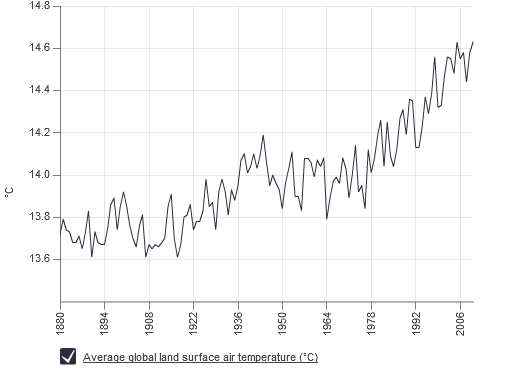Greenhouse Gas Emissions Overview
Climate change is the result of an increase in heat-trapping (greenhouse) gases in the atmosphere. Carbon dioxide (CO2) is the major long-lived greenhouse gas (GHG). The burning of fossil fuels (to provide electricity, heat and transportation, and to support industry and agriculture), as well as deforestation, leads to emissions of CO2 and increased levels of atmospheric CO2. The atmospheric concentration of CO2 has increased from a preindustrial level of 270–280 parts per million (ppm) to a level of approximately 390 ppm in 2010 (see Figure 1).
Global temperature records have been reported independently by scientists at the National Aeronautics and Space Administration (NASA) in the U.S., the National Oceanic and Atmospheric Administration in the U.S., the Climate Research Unit at the University of East Anglia in the U.K. and the Japanese Meteorological Agency. The records from these four independent groups are in good agreement and show a distinct warming trend over the past century. The past decade was the warmest decade in the instrumental temperature record. As shown in Figure 2, the warming trend is continuing, and 2010 was one of the warmest years on record. Independent measurements of rising sea level, increasing acidification of the oceans, loss of Arctic sea-ice, and the retreat of glaciers around the world are consistent with the impact of rising GHG concentrations and global temperature.
Figure 1: CO2 concentration measured at the observatory in Mauna Loa, Hawaii
Data source: NOAA (2011)
Figure 2: Global temperature

Data source: NASA (2011)
Global Emissions
Figure 3 (below) provides a breakdown of estimated 2008 fossil fuel CO2 emissions by region. For the U.S. and Europe, the emissions are further broken down by sector and by mode in the transportation sector. The data were taken from reports published by the International Energy Agency, the European Environment Agency and the U.S. Environmental Protection Agency. Globally, emissions from cars and light-duty trucks comprise about 11 percent of all fossil fuel CO2 emissions. In the U.S., cars and light-duty trucks account for approximately 20 percent of fossil fuel CO2 emissions, or approximately 4 percent of global fossil fuel CO2 emissions. In Europe, passenger cars and light-duty trucks account for approximately 19 percent of fossil fuel CO2 emissions, or about 3 percent of global fossil fuel CO2 emissions.
Until recently, the U.S. was the largest CO2 emitter. In 2007, however, emissions from China surpassed those from the U.S. It is expected that the gap between emissions from China and the U.S. will continue to widen in the future, although per-capita emissions of CO2 in the U.S. are expected to remain higher (currently by approximately a factor of four) than those in China.
Figure 3: Regional distribution of fossil fuel CO2 emissions in 2008

The top pie charts show a breakdown of U.S. emissions into end-use sectors and a breakdown of emissions from the U.S. transportation sector into different transportation modes. The bottom pie charts show comparable data from the EU.
Lifecycle Vehicle Emissions
The GHG emissions associated with Ford’s activities include emissions from our facilities, from the transportation of our products and people, from the vehicles we produce once they are in use by customers and from our suppliers. In this report, we provide data on CO2 emissions from our facilities and our U.S. and European new products. Additional information on our GHG footprint is found in the Lifecycle Vehicle CO2 Emissions section.
For conventional gasoline- or diesel-powered vehicles, most of the lifecycle CO2 emissions are released when the vehicles are driven, rather than when they are manufactured, maintained or recycled at end of life. As vehicle fuel efficiency improves and lower-carbon fuels are made available, we expect that the relative contribution of CO2 emissions from the fuel-consumption phase will decrease (see Lifecycle Vehicle CO2 Emissions). For Plug-in Hybrid Electric Vehicles (PHEVs), Battery Electric Vehicles (BEVs) and hydrogen-powered Fuel Cell Vehicles (FCVs), most of the lifecycle CO2 emissions are released during the production of the electricity or hydrogen that provides the energy for the vehicle. A systems perspective is required when considering the CO2 emissions and energy use associated with light-duty vehicle technologies. Considering either the vehicle technology or the fuel technology in isolation is not sufficient. BEVs and FCVs are capable of achieving very low CO2 emissions, but only when powered by low-CO2 electricity or hydrogen. The use of energy-efficient vehicles such as BEVs or FCVs does not in itself lead to a reduction in CO2 emissions; those vehicles need to be combined with low-CO2 fuels to achieve low total CO2 emissions.
The estimation of lifecycle CO2 emissions associated with myriad possible future vehicle-fuel combinations is a complex task. Scientists at Ford are working to develop a detailed understanding of the lifecycle impacts of the different technologies. We anticipate this will be an ongoing effort and that we will discuss the results in future Sustainability Reports.
- Overview
- Economy Data
- Environment Data
- Society Data
